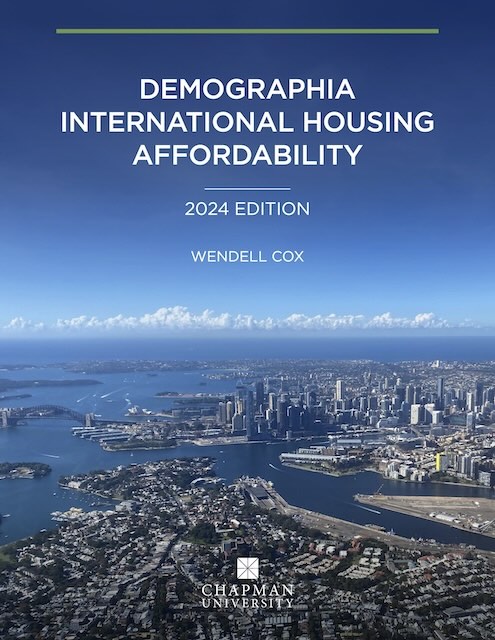Most major cities that were unaffordable in 2022 became even more unaffordable in 2023, according to Wendell Cox‘s latest annual report on international housing affordability. The major exception is in New Zealand, where land-use reforms have led to a home construction boom and increased housing affordability.
 Click image to download this 3.3-MB 33-page PDF.
Click image to download this 3.3-MB 33-page PDF.
He has been doing these reports since 2005 so this may be his 20th report (though he may have missed 2021). This year’s report, which is based on data from the third quarter of 2023, examines affordability in 94 housing markets in eight English-speaking countries: Australia, Canada, China (Hong Kong only), Ireland, Singapore, the United Kingdom, and the United States. Of these 94 markets, the least affordable are Hong Kong, Sydney, and Vancouver while the most affordable are Pittsburgh, Rochester, and St. Louis.
Cox blames housing affordability problems on urban containment policies such as growth boundaries, greenbelts, and densification. Such policies, he says pose an “existential threat to the middle-class.”
A New Zealand homebuilder will build this 1,300-square-foot, 3-bedroom home for you for about $240,000 — not including the land. Fortunately, land prices are declining thanks to new government policies.
New Zealand is leading the way out of this crisis. The national government has required local governments to rezone enough rural land to accommodate 30 years of population growth. As a result, the number of homes being built is 50 percent greater than population growth. This has made New Zealand the only country in Cox’s analysis that has improved affordability.
Oregon used to have a policy requiring cities to maintain sufficient land within their boundaries to allow for 20 years of population growth, which is why Oregon housing is less expensive than California’s. However, land-use groups such as 1000 Friends of Oregon challenged nearly every expansion proposed by every city. In 1993, the legislature allowed cities to “accommodate” growth through densification rather than expanding boundaries, which has failed to help affordability.
Cox quotes Jane Jacobs, who said that planning should make people better off, not worse off. Since she wrote that, planning has made millions of people far worse off by making housing unaffordable. “We must reorient current policies on land use and focus on the most fundamental objective: what is good for people,” concludes Cox.









Once again Cox, O’Toole and Kotkin are MISLEADING you.
IF California had 100 PERCENT of its land urbanized, it could still have unaffordability issues especially along the coast. Not all of the land in the state is the same.
Furthermore, modern urban planning (supported by these folks) consumes too much desirable land thanks to codes and zoning. When you have multifamily housing heavily separated from commercial along with retail/restaurant heavily split from offices and these inefficient arterial collector routes, land that could have been used for housing gets wasted.
Examples: Parts of Silcon Valley, Irvine/Costa Mesa, and UTC area of San Diego.
@Cyrus992,
So because Santa Monica would remain unaffordable, that means removing land-use restrictions is pointless, although it would make other areas affordable? It’s either all places become affordable or nothing? In your mind, you wrote this post believing this makes sense for you?
My point is that if you got rid of ALL land use restrictions in CA, Santa Monica can see prices fall but still far more expensive than the national average.
CA needs more growth horizontally BUT ALSO VERTICALLY.
And I’m saying that your point is asinine, especially given the fact that you said @The Antiplanner is being misleading. That’s like criticizing a drug that would cure 95% of the population because 5% would remain incurable.
What exactly would growing “VERTICALLY” do? People want houses, not tiny apartments. They move across states to buy houses, not apartments.
Cyrus, you should be a fisherman. You have enough red herrings in your comment to fill a trawler.
1) Who is talking about urbanizing 100% of California? No one I’ve ever read has pushed that concept.
2) Of course view property, like along the California coast or the penthouses of tall buildings, will always be expensive. But a sliver of land along the coast or on top of towers, doesn’t measurability impact affordability for the 99.99% of other locations.
3) Your criticisms of urban planning are so convoluted, I assume you are smoking some pretty good crack. Separating dense residential from commercial in parts of California may cause issues, but affordability isn’t one of them. Portland jams dense residential and commercial together and the impact on affordability is bad.
The bottom line is: if you have a growth boundary, it increases the cost of land within that boundary. That increased land cost results in denser buildings, i.e., multi-story residential structures being built on the more expensive land. Since sq.ft. cost of multi-story buildings is significantly higher than 1 to 2-story structures and the land costs are more, presto, you have much more expensive housing which leads to, wait for it, an affordability crisis!
O’Toole talks about how 5% of the state is urbanized thus increasing the share would lead to lower prices.
Building inland would not make Santa Monica, Del Mar, and Sausalito more affordable. Most of the highly desired land is gone. Even near coastal areas codes have resulted in vast parking lots and single use commercial buildings near the coast thus resulting fewer housing.
Minneapolis and Austin loosened their height/density requirements which expanded housing supply and lowered prices.
Why do you assume that all of us who criticize “sprawl” and folks like O’Toole support urban growth boundaries?
Affordable housing being built today actually costs much more than market-rate housing, and most of the benefits from building such expensive homes are contractors who install shit.
Most affordable housing projects regardless of height have to be built steel/concrete. They’re not mandating it because of fire/safety. They have to build something that’ll withstand decades of abuse from having to house inadvertently the dregs of society.
In the middle city lie Iberville housing projects, build in 40’s, The Iberville Project consisted of seventy-five brick buildings with 858 apartments. It was designed to blend in with the old neighborhood’s housing in terms of proportionality, size, and style, resembling rowhouses of the 19th century. Unlike other projects, there is far less crime and vandalism. Because it resembles the housing stock people would pay millions to buy as a townhouse.
Antiquated zoning laws are hallmark of contemporary neighborhood designs. They’re
– unwalkable
– confusing
– dangerous to cross their access roads on foot (Stroads)
– Universally adopt single housing plan
Years ago, Architect/Designer Marianne Cusato presented..for Build magazine
The New Economy Home 1.0
https://www.mariannecusato.com/the-new-economy
Designed to be efficient to both build and to maintain over time. The small and simple footprint is based on standardized dimensional lumber purchaseable at Any hardware store to minimize cutting on site.
Unlike the McMansion, which requires shit load of guesswork, high volume, low skill labor with loads of jerry rigging.
https://static01.nyt.com/images/2010/10/17/magazine/17KeySmallHouse/17KeySmallHouse-t_CA0-articleLarge.jpg
Once again the tools of 150 year old industrial revolution aid housing build.
applied same plan to her next plan “Katrina cottage” modular housing plan between 500-1700 sq feet plans
https://static.wixstatic.com/media/d0b984_7c6833e9181e40ac96531145dbe11e59.jpg/v1/fill/w_1649,h_987,al_c,q_85,usm_0.66_1.00_0.01/d0b984_7c6833e9181e40ac96531145dbe11e59.jpg
What we need in affordable housing market, bring back housing stock industry largely gave up on.
More Cape Cods, more bungalows, more bungalow courts, more shotgun homes.
Some specific areas are too high of a demand where structures under 3 stories cannot suffice.
Cyrus992,
Places like Sausalito do not exist in a vacuum. The price of housing in Sausalito is influenced by the price in Oakland, which is influenced by the price in Walnut Creek, which is influenced by the price in San Ramon. Allowing more development east of San Ramon would reduce the price in San Ramon etc.
We know this because in 1969, when there were no constraints on sprawl, Marin County provided relief for prices in San Francisco and as a result prices in San Francisco were not significantly less affordable than anywhere else in the country. Today more than 80 percent of the land in Marin County is off limits to development, which makes housing in Marin County more expensive but also makes housing in San Francisco more expensive.
So, your point is that IF we went back to policies of 1969, Marin County would be as affordable as the national average?
YES, removing the land restrictions would help but growth ALSO needs to be done VERTICALLY.
It is harder to build an infill 5 story building in Marin County, San Francisco, Santa Monica now than 90+ years ago or even places like Las Vegas, Austin, Chicago, Tokyo or Dubai.
Why don’t you talk about how the SF Board of Supervisors voted to extend height restrictions recently?
@Cyrus992 So let’s get this straight. You believe that “removing the land restrictions would help,” but said that “Cox, O’Toole and Kotkin are MISLEADING” because some areas would still remain expensive, then said, without evidence, tall buildings would help? Your only goal here is to engage is argument. There is nothing to criticize here since you agree with the article.
Yes, they are misleading by trying to make the public ONLY believing that expanding housing supply can only be done horizontally.
You have to reveal the whole picture to understand the problem and solution.
Not all of the land in CA is the same. Some are more desirable than others. IF you expand vertically, you can ALSO increase the supply/competition.
Examples: Austin and Minneapolis.